Seize the Momentum: 27 Templates for Successful Conference Follow-up Letters
Welcome to the “Conference Follow-up Letters” section of our website! Here, you’ll find valuable resources and insights on how to effectively follow up after attending a conference. Follow-up letters are an essential part of maximizing the impact of your conference experience. They allow you to express gratitude, nurture connections, explore collaboration opportunities, and continue the conversation beyond the event itself. Whether you’re looking to thank organizers, reach out to new contacts, propose collaborations, or share valuable information, our collection of templates, guidelines, and best practices will help you craft personalized and compelling follow-up letters.
Benefits of Follow-up Letters
Follow-up letters after a conference offer significant benefits to both the sender and the recipient. These letters play a crucial role in strengthening relationships by expressing gratitude and acknowledging the contributions of attendees, speakers, and organizers. These letters provide an avenue for expanding networks. They serve as a valuable tool for solidifying new connections made during the conference and initiating further engagement. By reaching out to fellow attendees, industry experts, or potential collaborators, these letters open doors for future collaborations, joint projects, and knowledge-sharing opportunities. Expanding networks through follow-up letters enhances professional growth by creating a diverse and supportive community of like-minded individuals.
Overall, follow-up letters after a conference contribute to relationship building, network expansion, and professional growth. They facilitate ongoing communication, foster collaboration, and provide a platform for continued learning and development. By recognizing the benefits of follow-up letters and leveraging them effectively, both the sender and the recipient can maximize the value gained from their conference experience and pave the way for future opportunities.
Guidelines and Tips
Here are some guidelines and tips for writing effective follow-up letters after a conference:
- Tone: Maintain a professional and polite tone throughout the letter. Be sincere and express gratitude when appropriate.
- Structure: Follow a clear and organized structure for your letter. Begin with a warm greeting, introduce yourself if necessary, mention the conference and your connection, provide the main content, and end with a closing remark and your contact information.
- Personalization: Personalize the letter by mentioning specific details from the conference, such as memorable moments, shared discussions, or common interests. This shows that you paid attention and value the interaction.
- Timing: Send the follow-up letter within a week after the conference. This ensures that the event is still fresh in the recipients’ minds and demonstrates your promptness and professionalism.
- Appropriate Recipients: Tailor the letter to the appropriate recipients based on the purpose of your follow-up. For example, if it is a thank you letter, send it to the organizers, speakers, and fellow attendees who made a significant impact on your experience.
- Focus on Benefits: Highlight the benefits or value derived from the conference in your letter. This could include knowledge gained, new connections made, potential collaborations, or insights that will contribute to your professional growth.
- Be Specific: Be specific when expressing your appreciation or referring to particular sessions, presentations, or interactions. This demonstrates attentiveness and shows that you are genuinely interested in the conference outcomes.
- Follow-Up Action: If there is a specific action you wish to take or discuss further, clearly state it in your letter. This could be requesting a meeting, sharing additional resources, or proposing a collaboration opportunity.
- Proofread: Proofread your letter thoroughly before sending it. Check for any grammatical errors or typos that could diminish the professionalism of your communication.
- Follow-Up Communication: Consider following up with a phone call or email if you haven’t received a response to your initial follow-up letter. This shows your persistence and commitment to building relationships.
#1: Thank You Letter:
The Thank You Letter is a powerful tool used to express heartfelt appreciation to the organizers, speakers, and attendees of a conference. It serves as a means to acknowledge their contributions, support, and presence, while also strengthening professional relationships. This letter not only shows gratitude but also helps maintain positive connections, encourages continued collaboration, and reflects the sender’s professionalism and etiquette. By expressing sincere thanks and highlighting specific aspects that made the conference memorable, this letter fosters a sense of goodwill and reinforces the value of everyone’s efforts in making the event a success.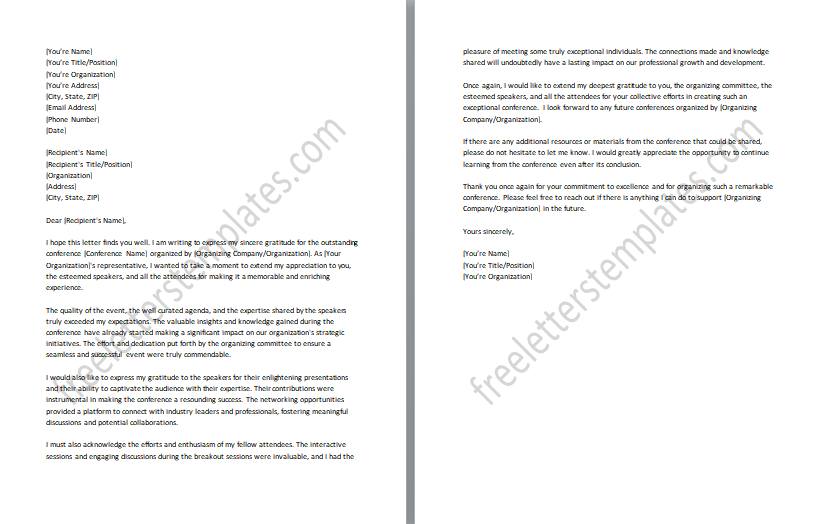
#2: Networking Letter:
A Networking Letter is vital in building and nurturing professional relationships established during a conference. Its purpose is to follow up with new connections made, foster further communication, and explore potential collaborations or partnerships. This letter serves as a means to express appreciation for the interaction, reiterate shared interests or discussions, and propose future engagements, such as meetings, phone calls, or joint projects. By sending a Networking Letter, individuals demonstrate their commitment to maintaining and expanding their network, creating opportunities for knowledge exchange, and fostering mutually beneficial connections in their respective fields or industries.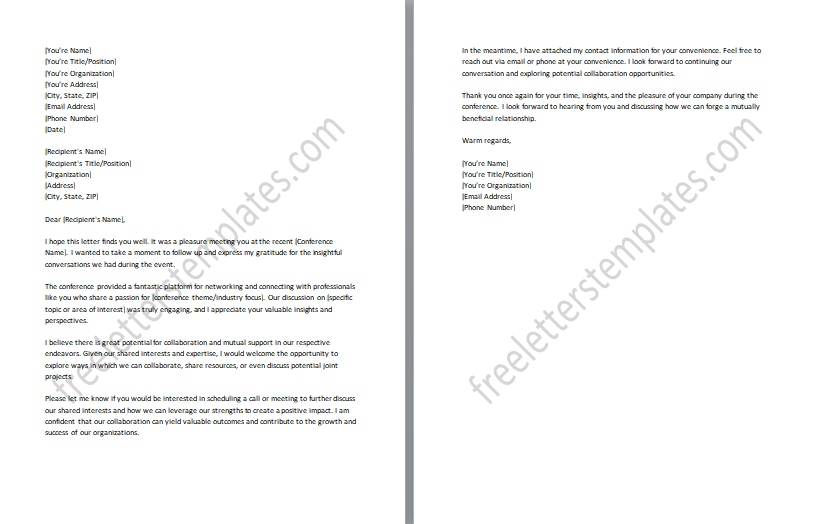
#3: Collaboration Proposal Letter:
A Collaboration Proposal Letter is a strategic communication tool used to propose potential collaboration opportunities to other attendees of a conference. Its purpose is to outline specific ideas, projects, or initiatives where a partnership or joint effort could be mutually beneficial. This letter highlights shared interests, complementary expertise, and the potential for leveraging resources and networks. By clearly articulating the benefits of collaboration and outlining a proposed plan of action, the sender aims to engage the recipient’s interest, encourage further discussion, and explore the feasibility of working together. The Collaboration Proposal Letter serves as a proactive step towards establishing valuable partnerships and fostering innovation through collaborative efforts.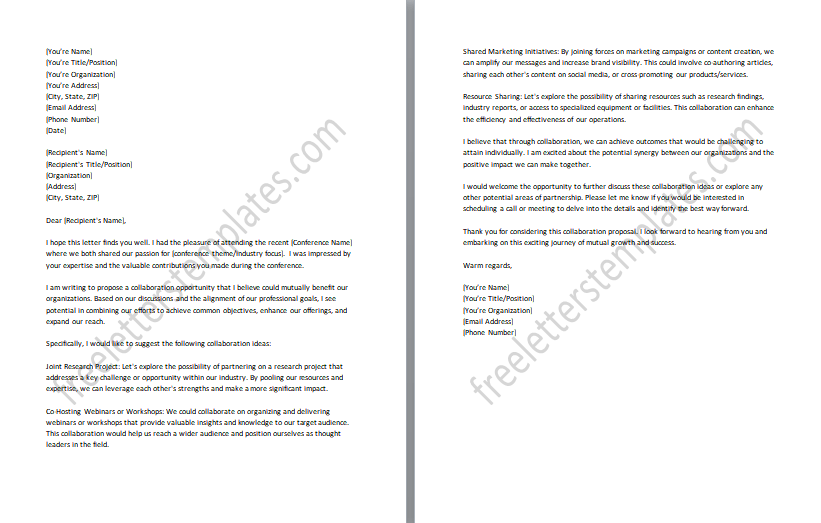
#4: Speaker Appreciation Letter:
A Speaker Appreciation Letter is a heartfelt expression of gratitude and recognition extended to a specific speaker for their valuable contribution to a conference. Its purpose is to acknowledge the speaker’s expertise, engaging presentation, and the impact they made on the audience. This letter serves as a means to convey sincere appreciation for the speaker’s time, preparation, and knowledge shared during their session. It often highlights specific aspects of the presentation that resonated with the audience and expresses how it has positively influenced their understanding or professional growth. By sending a Speaker Appreciation Letter, the sender not only shows gratitude but also nurtures a positive relationship with the speaker, fostering potential future collaborations or invitations for further engagements.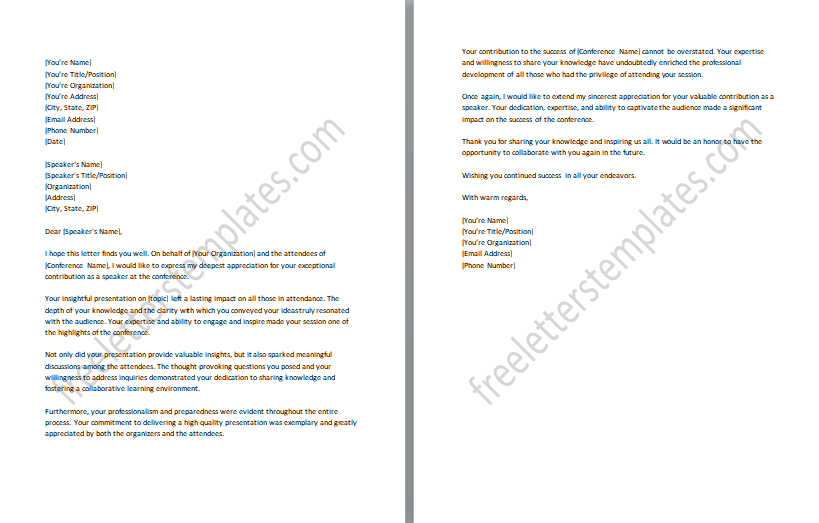
#5: Request for Presentation Materials Letter:
A Request for Presentation Materials Letter is a formal communication that seeks permission from speakers to obtain their presentation materials or slides from a conference. The purpose of this letter is to gather valuable resources for reference, educational purposes, or sharing within an organization. By reaching out to the speakers, the sender expresses interest in their content and the desire to access additional materials beyond what was presented during the conference. This letter typically includes details about the specific presentation, the purpose for which the materials will be used, and any preferred file format or delivery method.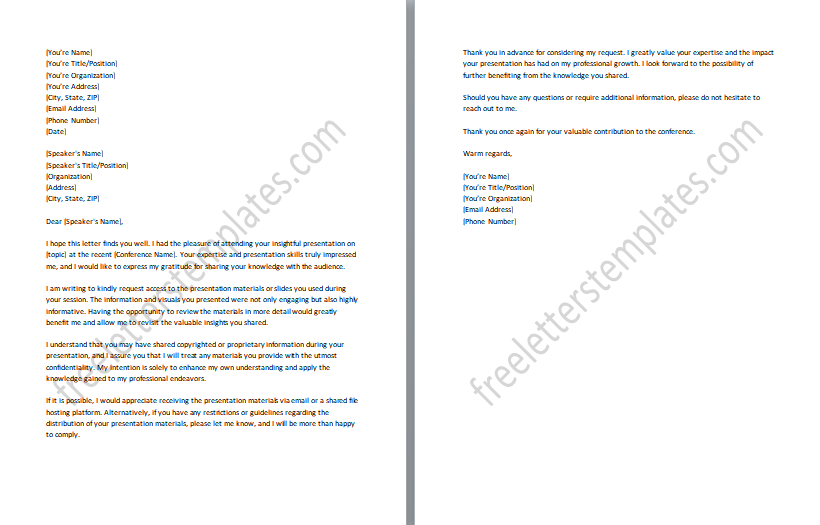
#6: Feedback and Suggestions Letter:
A Feedback and Suggestions Letter serves as a valuable tool for providing constructive feedback and offering suggestions to the organizers of a conference. Its purpose is to share insights, observations, and recommendations that can contribute to the improvement and enhancement of future conferences. This letter allows attendees to express their satisfaction with the event’s strengths, highlight areas for improvement, and propose innovative ideas or changes that could enhance the overall conference experience. By providing specific and actionable feedback, the sender aims to assist the organizers in understanding attendee perspectives, identifying areas of success, and addressing any shortcomings.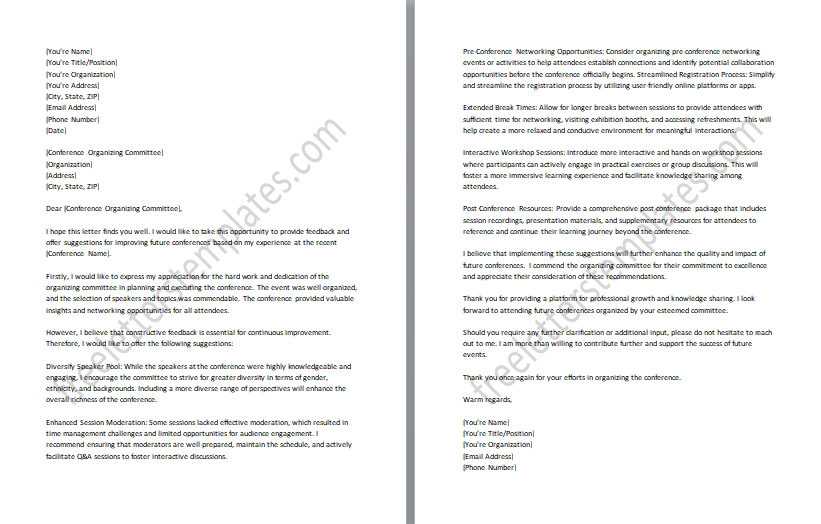
#7: Follow-up Meeting Request Letter:
A Follow-up Meeting Request Letter is a formal communication seeking to schedule a meeting with a specific attendee of a conference for further discussions and collaboration. Its purpose is to extend the conversation beyond the conference and explore potential opportunities or shared interests in more detail. This letter expresses the sender’s appreciation for the initial interaction and highlights specific points of discussion or areas of common interest that warrant further exploration. It proposes a meeting date, time, and location, while also offering flexibility to accommodate the recipient’s schedule. The letter serves as an invitation to continue the dialogue and explore avenues for potential collaboration, partnerships, or knowledge exchange.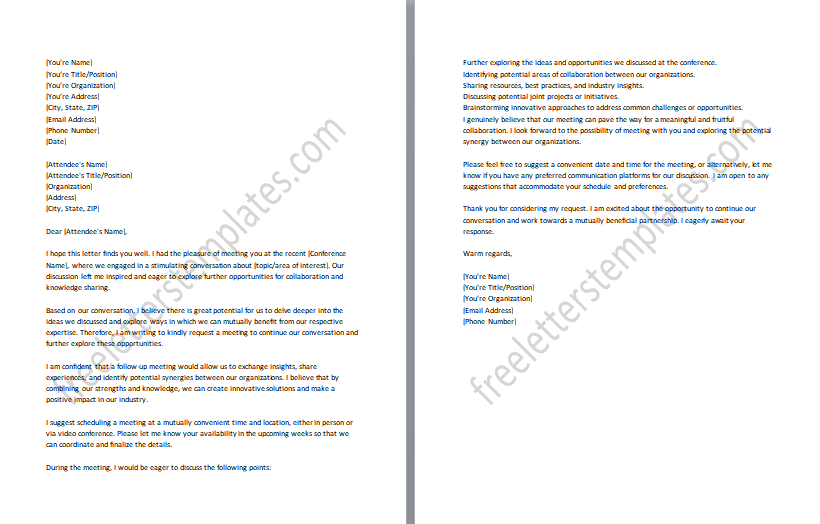
#8: Information Sharing Letter:
An Information Sharing Letter is a communication tool used to share additional resources or information that was discussed during a conference. This letter typically includes a summary of the information being shared, its relevance to the conference themes, and instructions on accessing or downloading the resources. By sending an Information Sharing Letter, the sender demonstrates a commitment to knowledge dissemination and provides attendees with an opportunity to delve deeper into the subject matter discussed during the conference. This letter promotes ongoing learning, facilitates the exchange of valuable information, and fosters a sense of continued engagement and support beyond the event itself.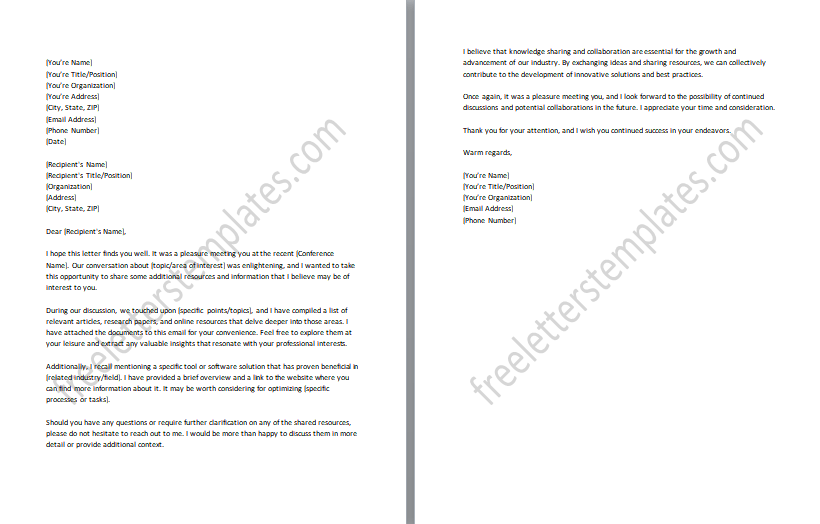
#9: Sales or Product Demonstration Letter:
A Sales or Product Demonstration Letter is a persuasive communication tool used to follow up with potential clients who have shown interest in a product or service during a conference. This letter highlights the unique selling points of the product or service and emphasizes how it can address the specific needs or challenges discussed during the conference. It typically includes information about scheduling a personalized demonstration, providing options for in-person or virtual meetings, and highlighting the availability of support or additional resources. The letter serves as an invitation to further explore the product and engage in a more detailed discussion regarding its potential benefits for the recipient’s specific requirements.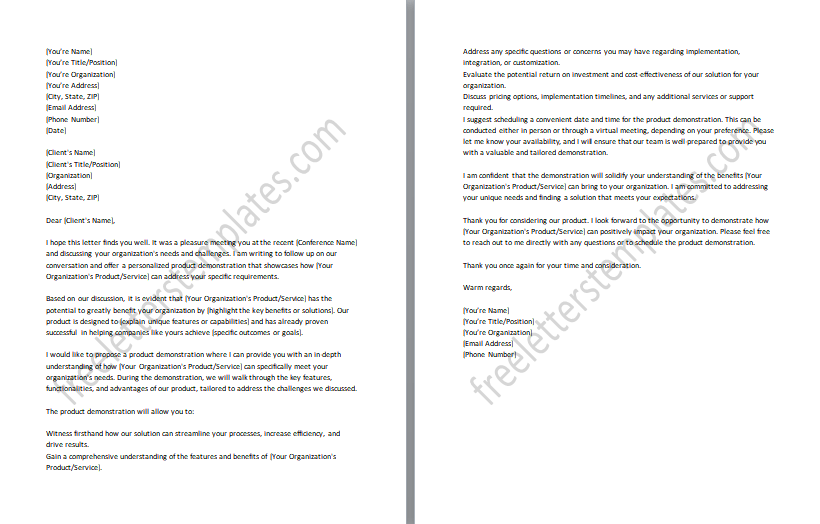
#10: Follow-up Job Application Letter:
A Follow-up Job Application Letter is a professional communication used to follow up with potential employers or recruiters whom you met during a conference. Its purpose is to express continued interest in a job opportunity, reiterate your qualifications and suitability for the position, and inquire about the status of your application. This letter serves as a reminder of your initial interaction, allowing you to stand out among other candidates and demonstrate your proactive approach to the job search process. It is important to express gratitude for the opportunity to connect during the conference, mention specific points of discussion or shared interests, and reiterate your enthusiasm for the position and the company.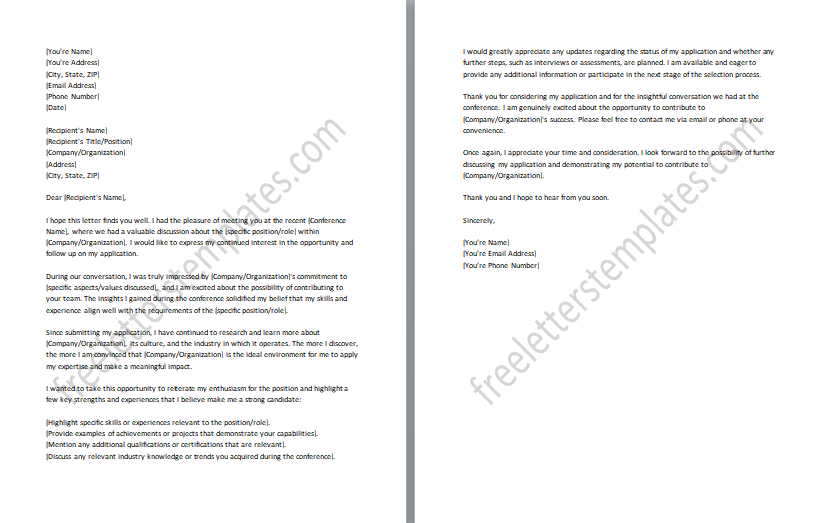
#11: Event Invitation Letter:
An Event Invitation Letter is a formal communication used to invite attendees of a conference to future events or webinars that are related to the conference theme or topic. It also highlights the relevance of the upcoming event to the conference attended and emphasizes the value it will bring to the participants. By sending an Event Invitation Letter, the sender aims to maintain the connection established during the conference, foster ongoing engagement, and encourage continued participation in related events. The letter serves as an invitation to expand your knowledge, network with like-minded professionals, and stay informed about developments in the field or industry.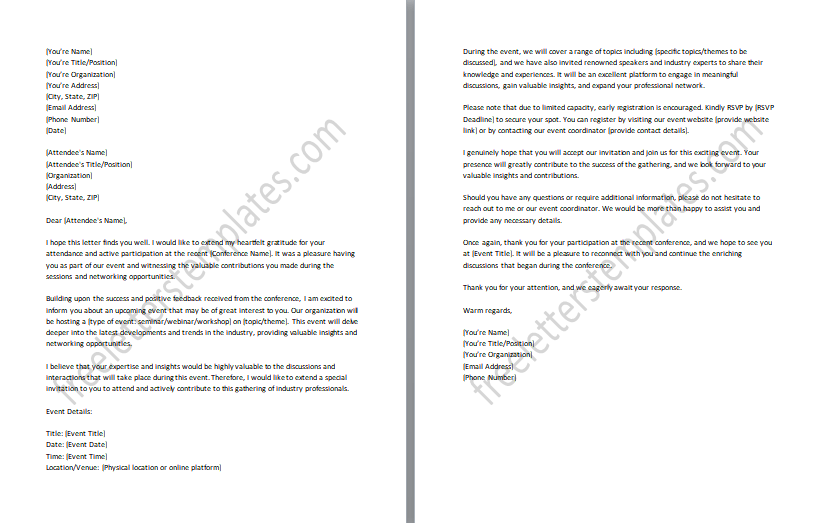
#12: Sponsorship Thank You Letter:
A Sponsorship Thank You Letter is a formal expression of gratitude extended to sponsors for their generous support of a conference. Its purpose is to convey sincere appreciation for the sponsor’s financial or in-kind contributions that made the event possible. This letter acknowledges the sponsor’s commitment to the conference’s success, highlights the impact of their support, and emphasizes the value it added to the overall experience for attendees. It may also mention specific benefits or visibility received by the sponsor during the conference. By sending a Sponsorship Thank You Letter, the sender not only shows appreciation but also nurtures a positive relationship with the sponsor. It provides an opportunity to strengthen the partnership, express a willingness to collaborate in the future, and reinforce the sponsor’s positive brand image within the conference community.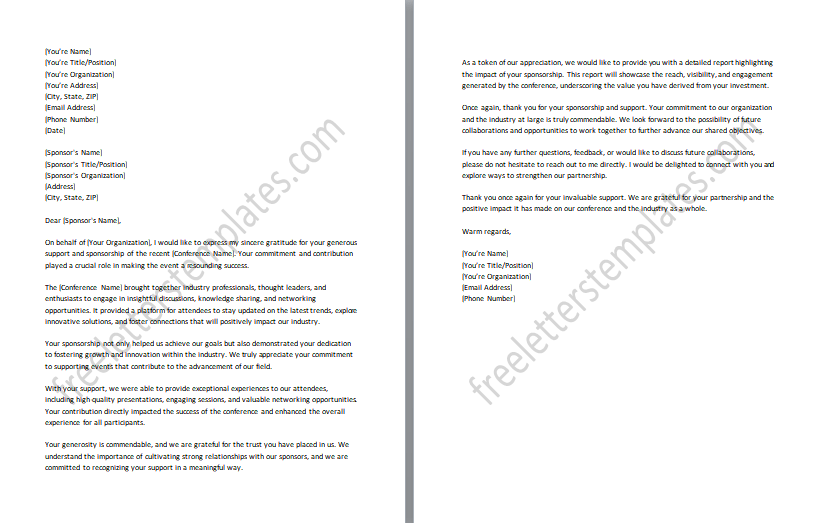
#13: Press Release Announcement Letter:
A Press Release Announcement Letter is a formal communication tool used to inform the media about the outcomes or major achievements of a conference. Its purpose is to generate publicity, attract attention, and highlight the significant contributions or notable results that emerged from the event. This letter typically includes a concise and compelling summary of the conference’s key accomplishments, such as groundbreaking research findings, impactful discussions, high-profile speakers, or noteworthy collaborations. It also provides relevant contact information for media inquiries and includes quotes or testimonials from key individuals involved in the conference. The letter serves as a formal invitation to the media to share the conference’s success stories and contribute to its broader impact.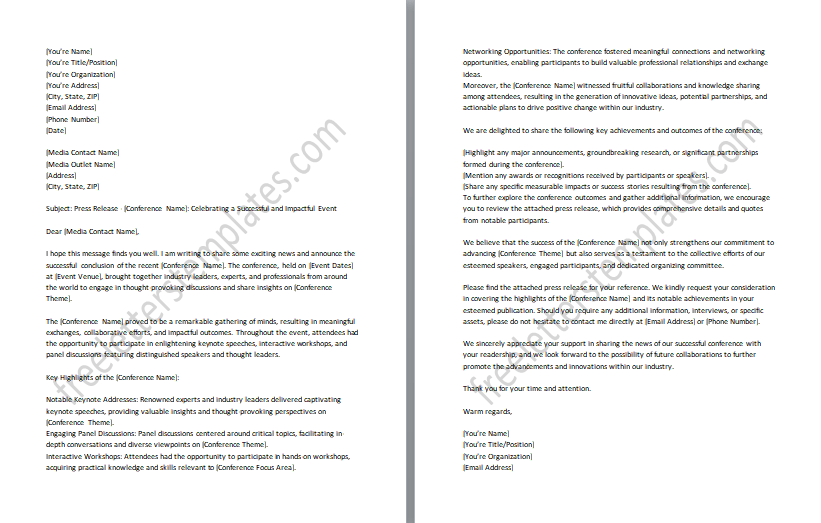
#14: Panel Discussion Recap Letter:
A Panel Discussion Recap Letter is a concise communication tool used to summarize the key points and highlights of a panel discussion that took place during a conference. Its purpose is to provide attendees and stakeholders with a recap of the insightful discussions and key takeaways from the panel. This letter typically includes a brief introduction to the panel topic and the names of the panelists. It may also highlight any actionable steps or follow-up initiatives that emerged from the panel. By sending a Panel Discussion Recap Letter, the sender aims to ensure that the valuable insights and knowledge shared during the panel are retained and disseminated to a wider audience. The letter serves as a resource for attendees to revisit the panel’s content, reinforces the conference’s value, and fosters continued engagement and discussion on the topic.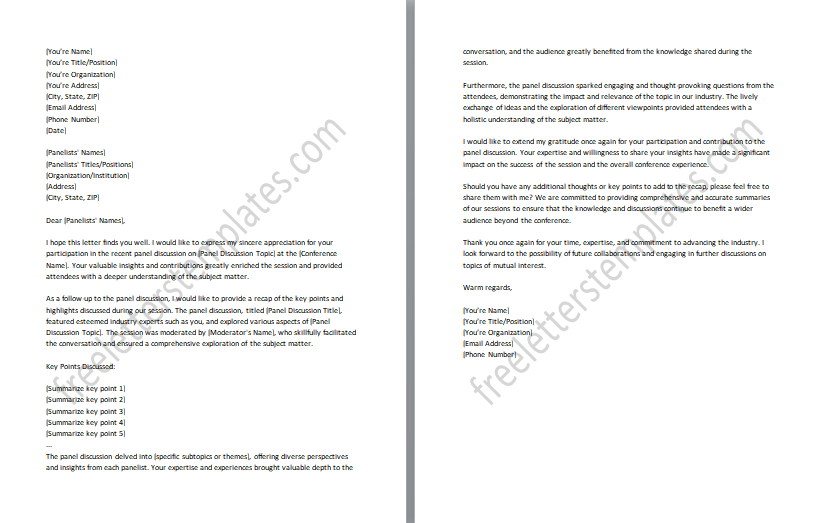
#15: Scholarship or Grant Application Letter:
A Scholarship or Grant Application Letter is a formal communication used to apply for financial assistance in the form of a scholarship or grant related to the conference theme. Its purpose is to present a compelling case for why the applicant deserves the scholarship or grant and how their participation in the conference aligns with the goals and objectives of the funding organization. This letter typically includes an introduction to the applicant, highlighting their qualifications, achievements, and reasons for seeking financial support. It also outlines how attending the conference will contribute to their professional development, knowledge enhancement, or research endeavors. The letter serves as a persuasive request for funding and demonstrates the applicant’s dedication to the conference’s theme and commitment to making a meaningful contribution to the field.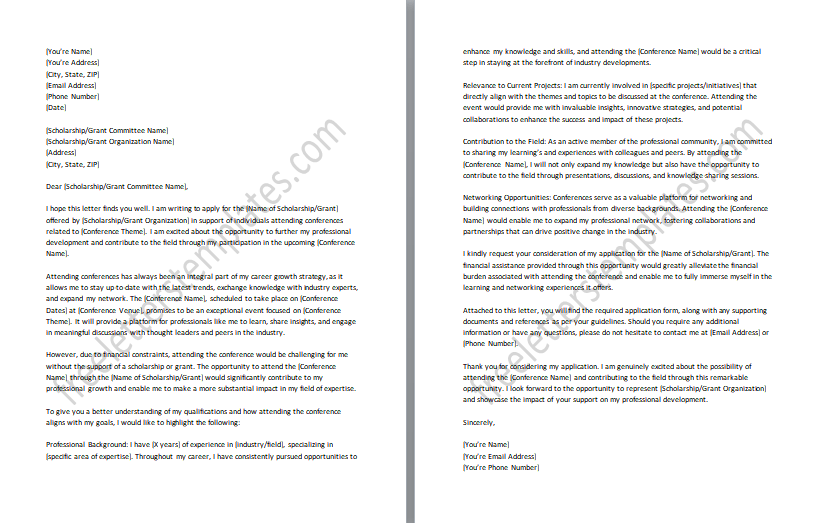
#16: Workshop Evaluation Letter:
A Workshop Evaluation Letter is a feedback tool used to provide an assessment of the quality and effectiveness of a workshop that was attended during a conference. Its purpose is to offer constructive feedback to the workshop organizers, facilitators, and presenters, helping them understand the strengths and areas for improvement. This letter typically includes an introduction mentioning the specific workshop attended, the date, and the names of the facilitators. It then proceeds to evaluate various aspects of the workshop, such as the content, delivery, organization, interactivity, and overall impact. It may highlight the strengths and commend the aspects that were particularly well-executed, while also providing suggestions or recommendations for enhancing the workshop in the future. By sending a Workshop Evaluation Letter, the sender contributes to the continuous improvement of workshops, assists the organizers in delivering high-quality sessions, and supports the overall success of future conferences.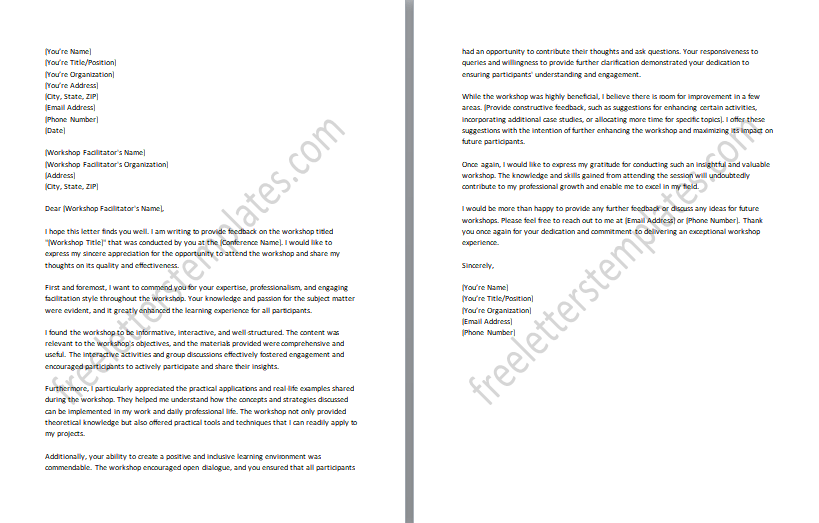
#17: Research Collaboration Proposal Letter:
A Research Collaboration Proposal Letter is a formal communication tool used to propose research collaborations based on discussions that took place during a conference. Its purpose is to outline the potential for collaboration, highlight shared research interests, and suggest ways in which the collaboration can be mutually beneficial. This letter typically includes an introduction to the sender and their research background, followed by a summary of the conference discussions or presentations that sparked the interest in collaboration. It then outlines the specific areas of research overlap or complementarity and proposes potential research activities, such as joint projects, data sharing, or collaborative publications. The letter may also address potential funding opportunities or the resources available for the proposed collaboration.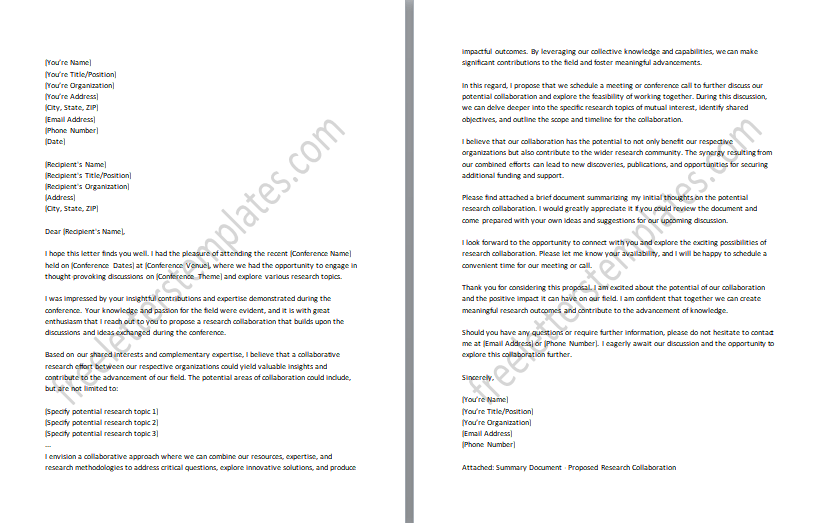
#18: Committee Membership Application Letter:
A Committee Membership Application Letter is a formal communication tool used to apply for membership in a committee or working group that was formed during a conference. This letter typically includes an introduction to the applicant, highlighting their qualifications, expertise, and relevant experience. It then proceeds to express a specific interest in the committee, describing how the applicant’s skills and knowledge align with the committee’s focus and objectives. The letter may also highlight any previous involvement or contributions to similar committees or working groups. By sending a Committee Membership Application Letter, the sender demonstrates their commitment to professional engagement, collaboration, and the advancement of the field.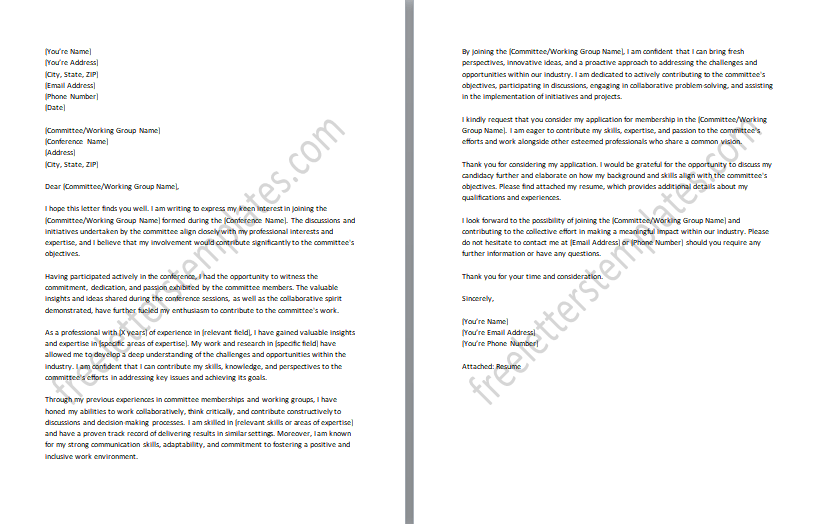
#19: Exhibition Booth Follow-up Letter:
An Exhibition Booth Follow-up Letter is a communication tool used to follow up with leads or potential customers who visited your exhibition booth during a conference. Its purpose is to maintain the connection established at the event, nurture the relationship, and further engage with the leads to explore potential business opportunities. This letter typically includes a warm and personalized introduction, expressing gratitude for the attendee’s visit to your booth and referencing any specific discussions or interactions that took place. It then proceeds to highlight the key benefits and value propositions of your products or services, tailored to the attendee’s expressed interests or needs. The letter may also offer additional resources, such as product brochures, samples, or links to relevant information on your website. It concludes with a call to action, encouraging the recipient to further engage with your company, whether it be scheduling a meeting, requesting a demo, or exploring collaboration possibilities.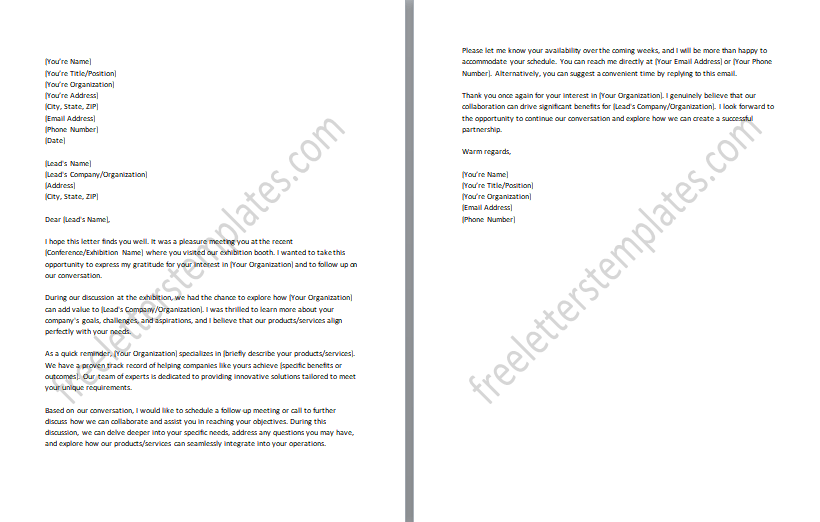
#20: Request for Permission to Share Presentation Letter:
A Request for Permission to Share Presentation Letter is a formal communication seeking the speaker’s consent to distribute their presentation materials. It expresses gratitude for their valuable contribution and highlights the benefits of sharing the content with a wider audience. The letter assures proper crediting and outlines any usage restrictions. By sending this letter, the sender aims to promote knowledge sharing, respect intellectual property rights, and facilitate collaboration within the conference community. It serves as a request to share the speaker’s expertise, ensuring their work reaches a broader audience and contributes to the advancement of the field.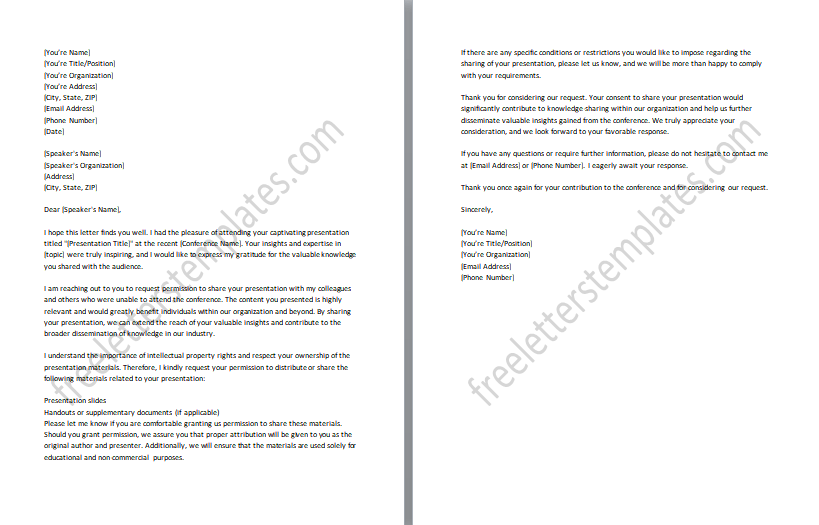
#21: Sponsorship Renewal Letter:
A Sponsorship Renewal Letter is a formal communication requesting sponsors to continue their support for future conferences. It expresses appreciation for their past contributions and highlights the positive impact of their sponsorship. The letter outlines the benefits of sponsorship, such as increased visibility and networking opportunities, and emphasizes the alignment between the sponsor’s values and the conference’s objectives. It may include specific sponsorship packages and associated perks. By sending this letter, the sender aims to nurture the relationship with sponsors, secure their ongoing support, and ensure the sustainability and success of future conferences. The letter serves as an invitation to further collaboration and mutually beneficial partnerships.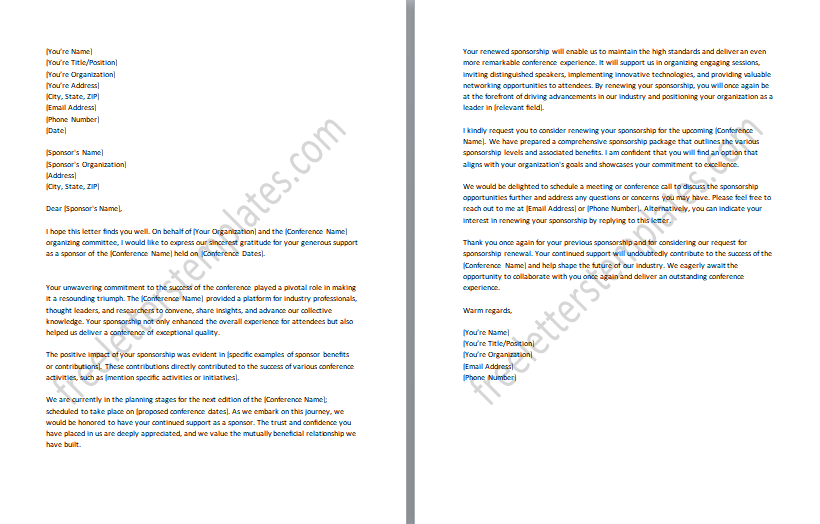
#22: Volunteer Appreciation Letter:
A Volunteer Appreciation Letter is a heartfelt communication used to express gratitude to volunteers for their exceptional dedication and hard work during the conference. It serves as a recognition of their invaluable contributions and the positive impact they have made on the success of the event. The letter acknowledges the volunteers’ commitment, professionalism, and willingness to go above and beyond. It highlights specific examples of their efforts and how they have positively influenced the conference experience for attendees and organizers alike. By sending a Volunteer Appreciation Letter, the sender aims to show sincere appreciation, foster a sense of community and teamwork, and encourage continued engagement and support from volunteers in future conferences.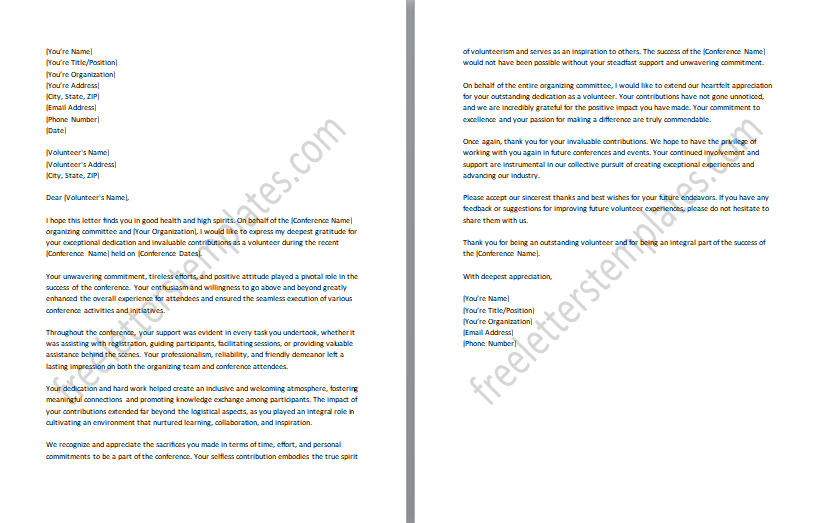
#23: Call for Papers Letter:
A Call for Papers Letter is an official announcement inviting researchers, scholars, and professionals to submit their papers for consideration in the next edition of the conference. Its purpose is to communicate the conference theme, submission guidelines, and important deadlines to potential contributors. The letter typically includes an introduction explaining the significance of the conference and its focus areas, followed by detailed instructions for paper submission, formatting requirements, and the review process. It may also highlight the benefits of presenting at the conference, such as networking opportunities and publication possibilities. The letter serves as an invitation to researchers to contribute their expertise, insights, and innovations to advance the field and enrich the conference experience.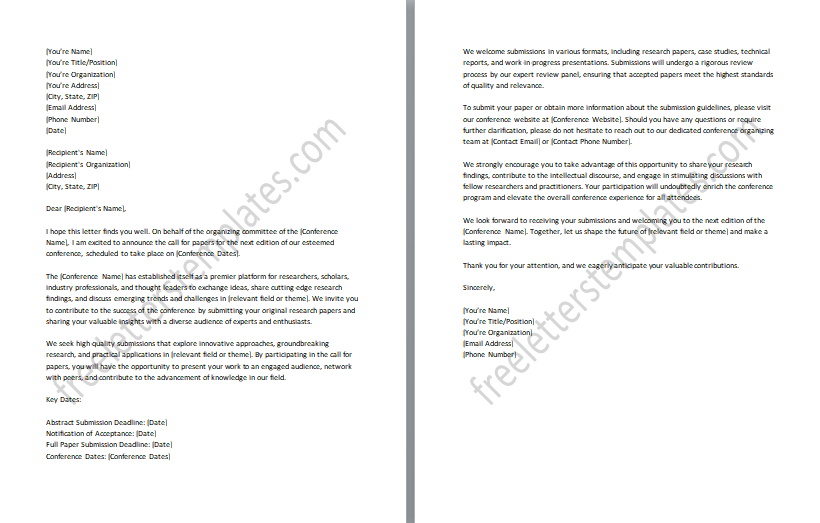
#24: Scholarship Winner Announcement Letter:
A Scholarship Winner Announcement Letter is a formal communication used to announce and congratulate the recipients of scholarships awarded during the conference. It serves to recognize the outstanding achievements, merit, and potential of the scholarship winners. The letter begins by expressing appreciation to all applicants and the selection committee for their participation and diligence in the evaluation process. It then announces the names of the scholarship winners and highlights the reasons for their selection. The letter may also provide details on the scholarship benefits, such as financial support, mentorship, or networking opportunities. By sending this letter, the sender aims to celebrate the recipients’ accomplishments, inspire others, and encourage continued excellence within the conference community.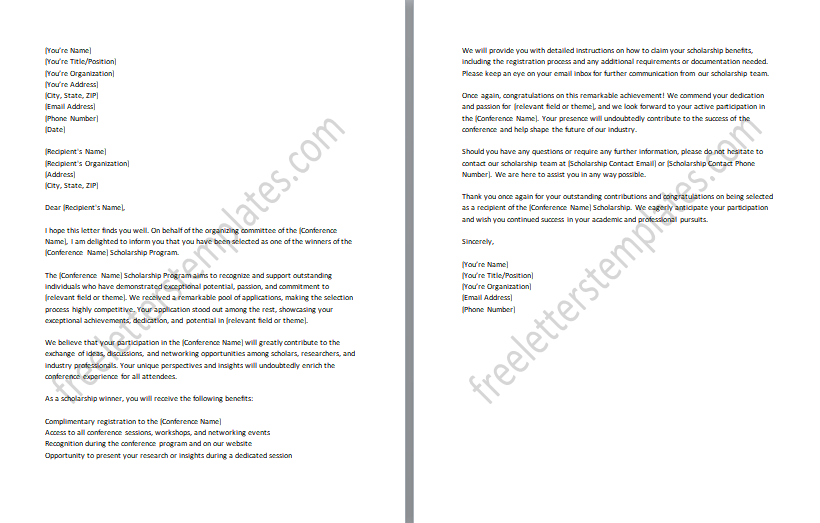
#25: Certification or Continuing Education Request Letter:
A Certification or Continuing Education Request Letter is a formal communication used to request certification or continuing education credits for attending a conference. The letter outlines the conference details, including the dates, location, and the educational sessions attended. It highlights the relevance of the conference content to the recipient’s professional development and explains the importance of obtaining certification or continuing education credits. The letter may include supporting documents, such as an agenda or certificate of attendance. The letter serves as a formal request for recognition of the educational value gained from attending the conference through the award of certification or continuing education credits.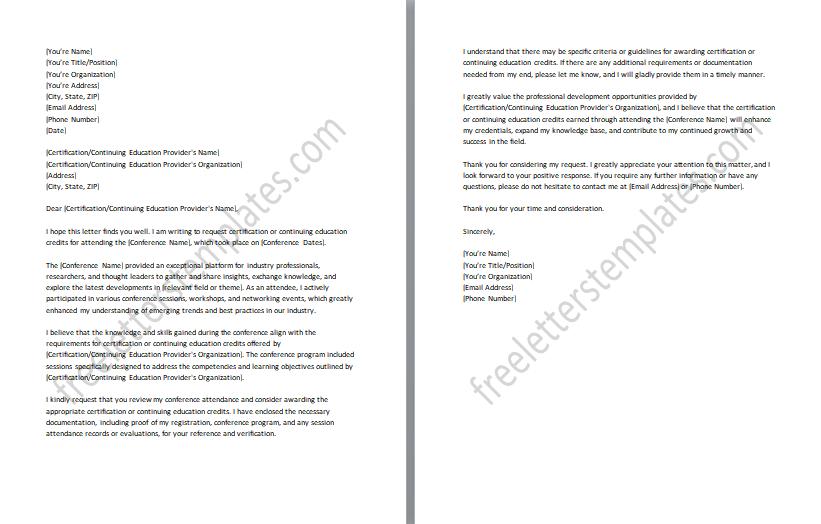
#26: Delegate Experience Survey Letter:
A Delegate Experience Survey Letter is a communication tool used to encourage conference attendees to participate in a post-conference survey to provide valuable feedback. The letter expresses gratitude for their attendance and highlights the importance of their input in shaping future conferences. It explains the purpose of the survey, such as evaluating the overall experience, session quality, networking opportunities, and organizational aspects. The letter assures respondents of the anonymity and confidentiality of their responses. It may also emphasize the benefits of participating, such as influencing future conference improvements and receiving exclusive access to survey findings. By sending this letter, the sender aims to gather valuable insights, enhance attendee satisfaction, and continuously improve the conference experience based on attendee feedback.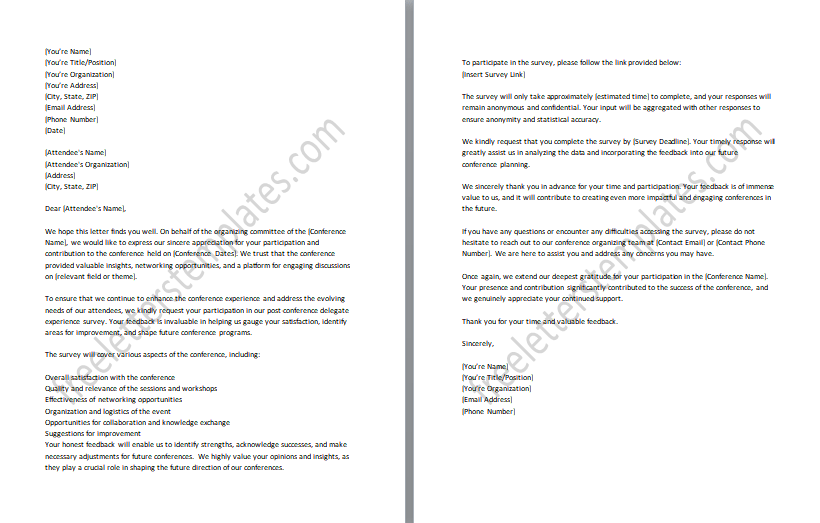
#27: Testimonial Request Letter:
A Testimonial Request Letter is a formal communication used to request attendees to provide testimonials about their experience at the conference. The letter expresses appreciation for their participation and highlights the importance of their feedback in showcasing the value and impact of the event. It explains the purpose of the testimonials, such as using them for promotional materials, website content, or future conference marketing. The letter may include specific questions or prompts to guide the testimonials, ensuring valuable and targeted feedback. It also assures respondents that their testimonials will be attributed to them appropriately and may include a consent form for their approval.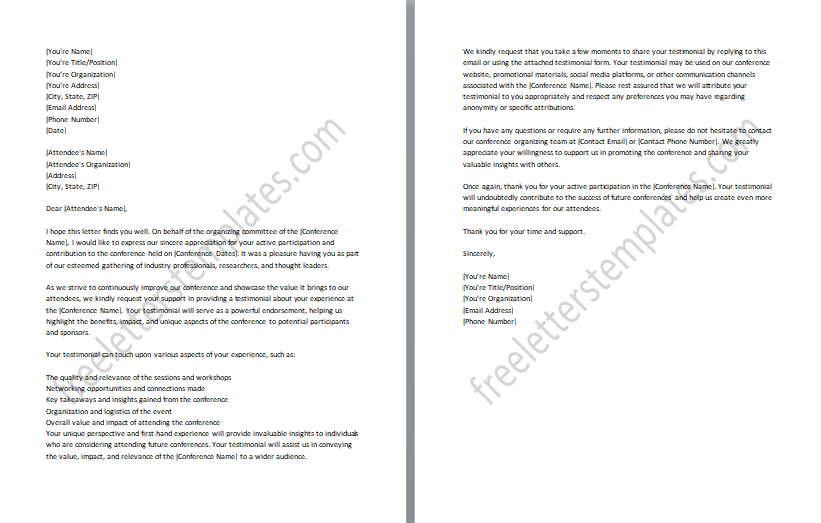
Best Practices for Crafting Effective Follow-Up Letters:
Here are some best practices for each type of follow-up letter to help visitors craft their own personalized and compelling letters:
- Thank You Letter:
- Do express genuine gratitude for the conference experience and the specific contributions of the organizers, speakers, and attendees.
- Do mention key takeaways or memorable moments from the conference.
- Don’t use a generic template without personalizing it to reflect your unique experience and interactions.
- Don’t forget to proofread the letter for any errors before sending it.
- Networking Letter:
- Do mention the specific connection or conversation you had with the recipient during the conference.
- Do express your interest in continuing the conversation or collaboration.
- Don’t be too pushy or demand immediate action from the recipient.
- Don’t forget to personalize the letter to make it relevant to the recipient’s interests or needs.
- Collaboration Proposal Letter:
- Do clearly articulate the potential benefits and opportunities of the proposed collaboration.
- Do highlight any shared interests or complementary expertise.
- Don’t make assumptions about the recipient’s interest or availability for collaboration.
- Don’t oversell or exaggerate the potential outcomes of the collaboration.
- Speaker Appreciation Letter:
- Do specify the speaker’s name and the impact their presentation had on you.
- Do express gratitude for their knowledge, insights, and presentation skills.
- Don’t use overly generic or vague compliments. Be specific about what you found valuable.
- Don’t forget to mention any specific actions or takeaways from the presentation that inspired you.
- Request for Presentation Materials Letter:
- Do clearly state the purpose of the request and how you intend to use the presentation materials.
- Do express appreciation for the speaker’s willingness to share their materials.
- Don’t forget to provide your contact information for the speaker’s convenience.
- Don’t share the presentation materials with others without the speaker’s explicit permission.
Concluding Thoughts:
- Follow-up letters are powerful tools that can enhance your professional relationships, expand your network, and open doors to new opportunities.
- Personalization is key when crafting follow-up letters. Tailor each letter to the recipient, referencing specific conversations or interactions to make it more meaningful.
- Remember to express genuine gratitude and appreciation in your follow-up letters. Acknowledge the contributions and efforts of others, whether it’s organizers, speakers, sponsors, or fellow attendees.
- Be concise and clear in your communication. Keep your follow-up letters focused and to the point, highlighting the main purpose or message you want to convey.
- Timing is crucial. Send your follow-up letters promptly after the conference to capitalize on the momentum and ensure that the experience is still fresh in everyone’s minds.
- Proofread your letters before sending them to avoid any spelling or grammatical errors. Pay attention to the tone and overall professionalism of your writing.
- Follow-up letters can lead to meaningful collaborations, job opportunities, or invitations to future events. Maximize their impact by being proactive, responsive, and open to further communication.
- Regularly assess the effectiveness of your follow-up letters and make adjustments as needed. Learn from each experience and refine your approach to improve future interactions.